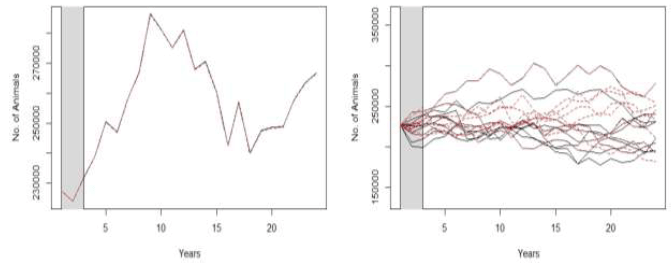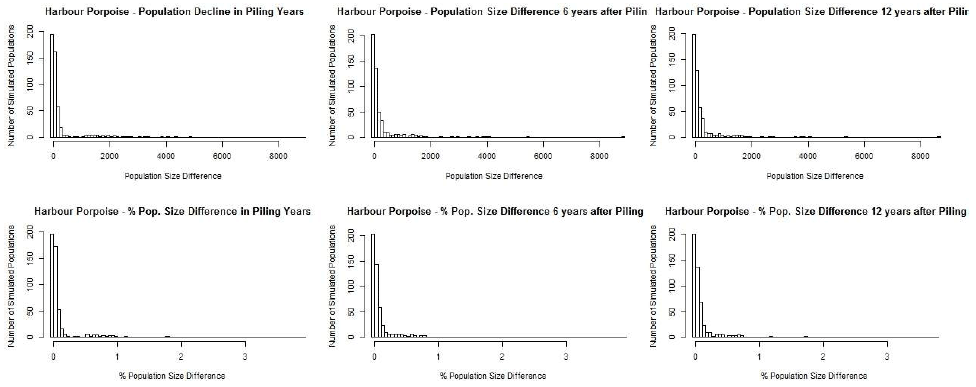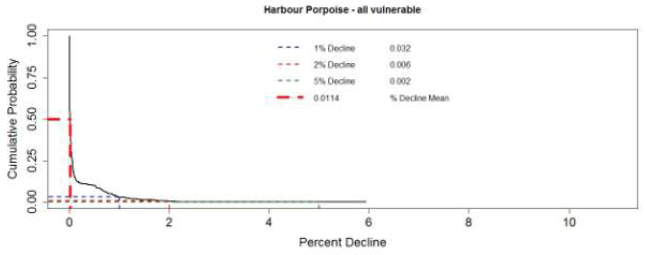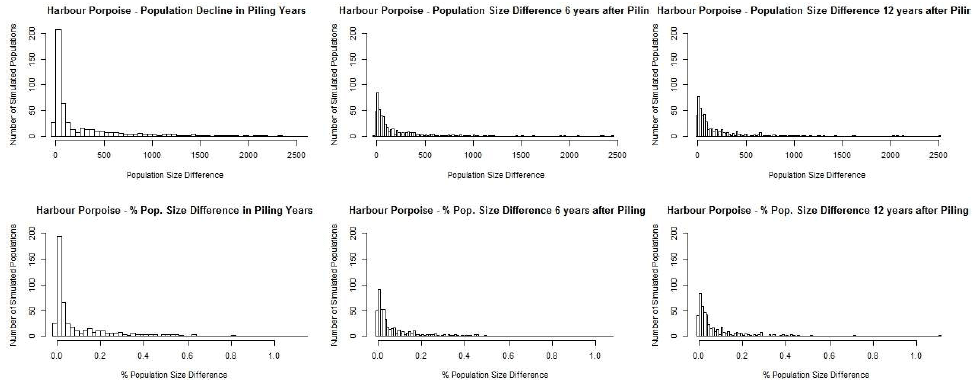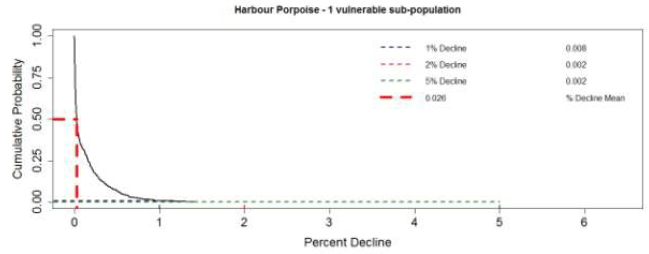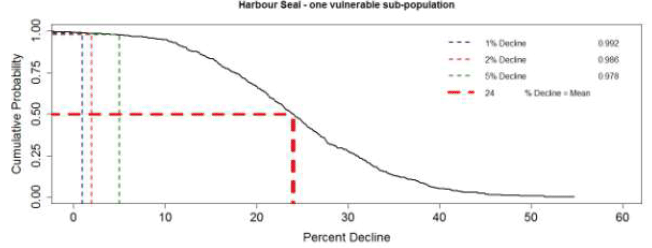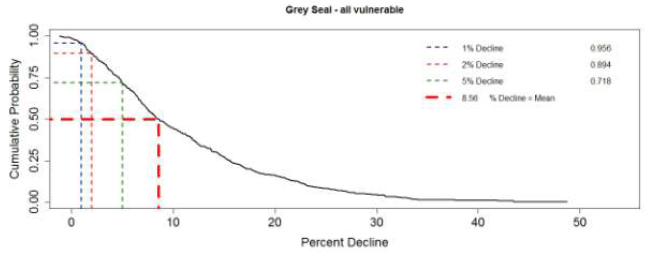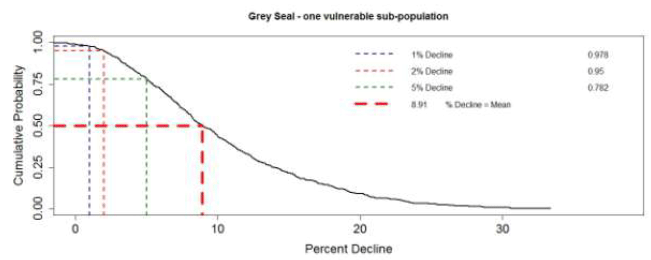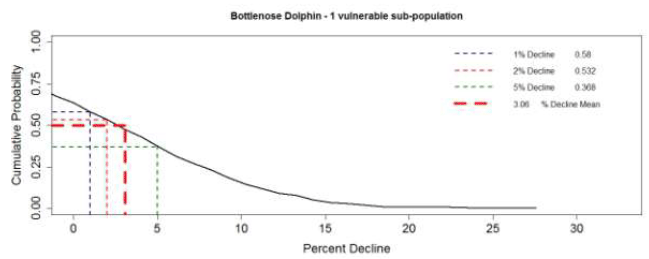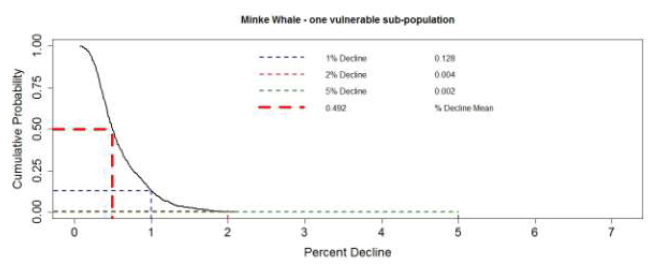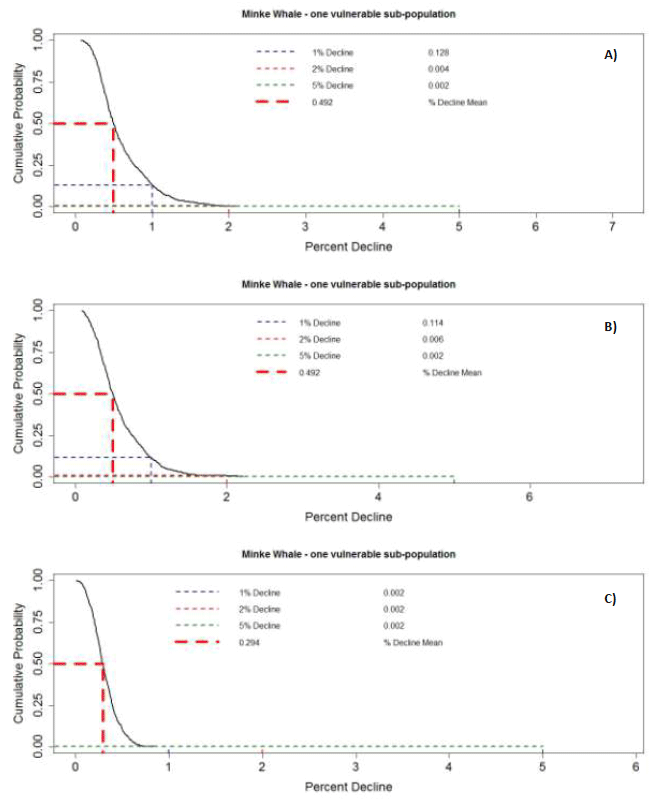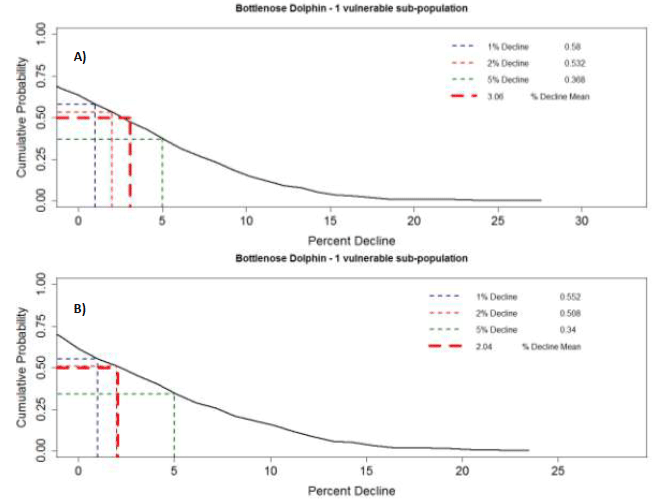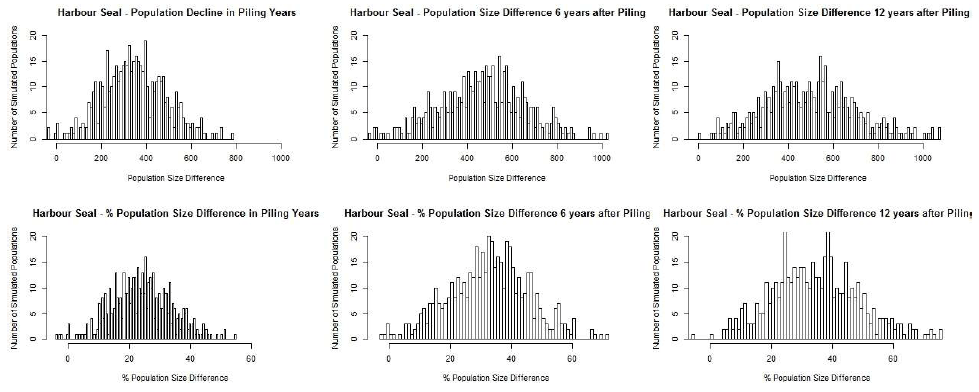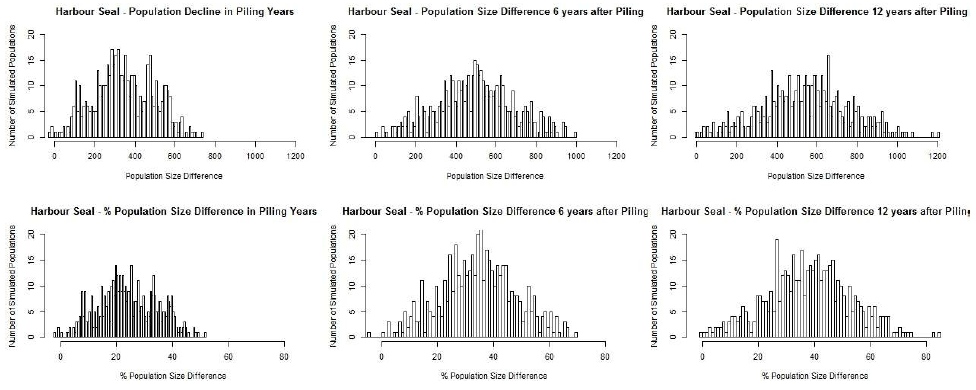Scottish Marine and Freshwater Science Volume 5 Number 2: A Protocol for Implementing the Interim Population Consequences of Disturbance (PCoD) Approach...
Report on developing a protocol to implement the interim Population Consequences of Disturbance (PCoD) Approach: quantifying and assessing the effects of UK offshore renewable energy developments on marine mammal populations
Results from the Illustrative Scenarios
The results described here are intended to demonstrate how the interim PCoD protocol could be implemented and to illustrate the kinds of output and summary information that it can generate. They should not be interpreted as predictions of the likely population-level effects of any actual offshore renewable energy developments.
We present detailed results for only one species (the harbour porpoise) in this section. For the other four priority species we present one figure, which summarises the risk that the population will have declined by at least 1%, 2% or 5% from its initial size immediately after construction work ends, for each species. The other figures may be found in Appendix 3.
North Sea Harbour Porpoises
Entire Population Vulnerable
Figure 7 shows the forecast trajectories for a sample of pairs of disturbed and undisturbed populations to illustrate the kinds of changes in population size that are expected to occur as a result of environmental variation, demographic stochasticity and disturbance. Most simulated disturbed populations showed no decline, reflecting the fact that no more than 0.5% of the population is likely to be disturbed on each day that piling occurs, and less than 0.01% of the population is likely to experience PTS on those days. Figure 8 summarises the changes, in absolute and relative terms, for all 500 simulated harbour porpoise populations, and Figure 9 shows the probability of various levels of decline in the year after construction work ends if the entire population is vulnerable to the effects of piling.
Figure 7. Examples of the predicted changes in abundance of the North Sea harbour porpoise population in the 24 years following the construction of two hypothetical wind farms. The left panel shows the trajectory of one disturbed population (shown as red dotted line) and the matching undisturbed population (shown as black solid line). The right panel shows the trajectories of 10 disturbed (shown as red dotted lines) and undisturbed (shown as black solid lines) populations.
Figure 8. The predicted effects of disturbance and injury associated with the construction of two hypothetical wind farms on 500 simulated harbour porpoise populations when all of the population is vulnerable to the effects associated with both wind farms. The top panels show the predicted differences between the size of the undisturbed and disturbed populations immediately after construction, and at 6-year intervals thereafter. Positive values indicate that the disturbed population is smaller than the undisturbed one. The lower panels show these differences expressed as a percentage of the population size before the start of construction.
Figure 9. The predicted effects of disturbance and injury associated with the construction of two hypothetical wind farms on 500 simulated harbour porpoise populations when all of the population is vulnerable to the effects associated with both wind farms. The figure shows the proportion of simulated populations that experienced declines of at least 1%, at least 2% and at least 5% at the end of the construction period, and the mean decline in abundance over this period.
One Vulnerable Sub-Population
Figures 10 and 11 show the equivalent information for a scenario in which only a proportion of the population is vulnerable to the effects of the piling operations. The differences are small, but a slightly higher proportion of the simulated disturbed populations showed some evidence of decline under this scenario.
Figure 10. The predicted effects of disturbance and injury associated with the construction of two hypothetical wind farms on 500 simulated harbour porpoise populations when 10% of the population is vulnerable to the effects associated with both construction sites and the remaining 90% of the population is not affected by either operation. The top panels show the predicted differences between the size of the undisturbed and disturbed populations immediately after construction, and at 6-year intervals thereafter. Positive values indicate that the disturbed population is smaller than the undisturbed one. The lower panels show these differences expressed as a percentage of the population size before the start of construction. (graphic)
Figure 11. The predicted effects of disturbance and injury associated with the construction of two hypothetical wind farms on 500 simulated harbour porpoise populations when 10% of the population is vulnerable to the effects associated with both construction sites and the remaining 90% of the population is not affected by either operation. The figure shows the proportion of simulated populations that experienced declines of at least 1%, at least 2% and at least 5% at the end of the construction period, and the mean decline in abundance over this period.
Moray Firth Harbour Seals
Figures for harbour seals, equivalent to those shown for harbour porpoises, can be found in Appendix 3. Fig. 12 shows the probability of different levels of decline at the end of the construction period. The estimates of the number of animals likely to be disturbed or experience PTS during one day of construction resulted in more than 20% of the population being disturbed each day, and more than 5% experiencing PTS. As a result, the implications for the population are much greater than they were for harbour porpoises. Most simulated populations showed a decline of more than 5%, and more than half had declined by at least 20% by the time construction ended. These declines continued, although not so steeply, in subsequent years because of the persistent effects of PTS on survival and fertility.
Figure 12. The predicted effects of disturbance and injury associated with the construction of two hypothetical wind farms on 500 simulated harbour seal populations when 50% of the population is vulnerable to the effects associated with both construction sites and the remaining 50% of the population is not affected by either operation. The figure shows the proportion of simulated populations that experienced declines of at least 1%, at least 2% and at least 5% at the end of the construction period, and the mean decline in abundance over this period.
Moray Firth Grey Seals
Figures for grey seals equivalent to those shown for harbour porpoises can be found in Appendix 3. Here we only show summary figures that illustrate the probability of different levels of decline at the end of the construction period. Figure 13 shows these probabilities for a scenario in which all animals in the population are vulnerable to disturbance, and Fig. 14 shows the equivalent probabilities when only half the population is vulnerable. The scenarios we have chosen resulted in 20% of the population being exposed to disturbance on each day of construction, and nearly 3% experiencing PTS on each day. Most simulated populations showed a decline of more than 2%, and nearly half of all simulated population had declined by at least 10% by the time construction ended. These declines continued, although not so steeply, in subsequent years because of the persistent effects of PTS on survival and fertility. The forecast declines are slightly higher when only half the population is vulnerable to disturbance because, on average, each individual in the vulnerable sub-population is disturbed on more days than is the case when all members of the population are equally vulnerable to disturbance.
Figure 13. The predicted effects of disturbance and injury associated with the construction of two hypothetical wind farms on 500 simulated grey seal populations when all of the population is vulnerable to the effects associated with both wind farms. The figure shows the proportion of simulated populations that experienced declines of at least 1%, at least 2% and at least 5% at the end of the construction period, and the mean decline in abundance over this period.
Figure 14. The predicted effects of disturbance and injury associated with the construction of two hypothetical wind farms on 500 simulated grey seal populations when 50% of the population is vulnerable to the effects associated with both construction sites and the remaining 50% of the population is not affected by either operation. The figure shows the proportion of simulated populations that experienced declines of at least 1%, at least 2% and at least 5% at the end of the construction period, and the mean decline in abundance over this period.
Coastal East Scotland Bottlenose Dolphins
Figures for bottlenose dolphins that are equivalent figures to those shown for harbour porpoises can be found in Appendix 3. Here we only show summary figures that illustrate the probability of different levels of decline at the end of the construction period. Figure 15 shows these probabilities for a scenario in which half the population is vulnerable to disturbance. The scenarios we chose resulted in around 5% of the total population being exposed to disturbance on each day of construction, and 1% experiencing PTS on each day. As a result, the implications for the population are greater than they were for harbour porpoises but substantially less than they were for harbour seals and grey seals. Most of the simulated populations had declined by less than 5% by the time construction ended.
Figure 15. The predicted effects of disturbance and injury associated with the construction of two hypothetical wind farms on 500 simulated bottlenose dolphin populations when 50% of the population is vulnerable to the effects associated with both construction sites and the remaining 50% of the population is not affected by either operation. The figure shows the proportion of simulated populations that experienced declines of at least 1%, at least 2% and at least 5% at the end of the construction period, and the mean decline in abundance over this period.
Minke Whales
Figures for minke whales that are equivalent figures to those shown for harbour porpoises can be found in Appendix 3. Here we only show summary figures that illustrate the probability of different levels of decline at the end of the construction period. Figure 15 shows these probabilities for a scenario in which 10% of the population is vulnerable to disturbance. The scenarios we chose resulted in less than 1% of the total population being exposed to disturbance on each day of construction, and only 1 in 1000 animals experiencing PTS on each day. As a result, the implications for the population are similar to those for harbour porpoises with very few simulated populations declining by more than 1%.
Figure 16. The predicted effects of disturbance and injury associated with the construction of two hypothetical wind farms on 500 simulated minke whale populations when 10% of the population is vulnerable to the effects associated with both construction sites and the remaining 90% of the population is not affected by either operation The figure shows the proportion of simulated populations that experienced declines of at least 1%, at least 2% and at least 5% at the end of the construction period , and the mean decline in abundance over this period.
Sensitivity Analysis
Harwood et al. (2013) investigated the sensitivity of the interim PCoD approach to assumptions made in estimating the number of animals that might experience PTS and 'significant' disturbance over the entire course of construction of an offshore renewable energy development. They found that these estimates were particularly sensitive to three of the assumptions of the model: the proportion of the population that is expected to be vulnerable to the effects of disturbance, the model used to assess the risk of PTS, and the duration of the 'residual' effect of disturbance. Here, we extend that analysis to investigate the sensitivity of forecasts of population-level effects to the same set of assumptions.
Proportion of Population Vulnerable to Effects
Figure 17 shows a comparison of the predicted declines for a minke whale population in which 10%, 5% and 1% of the population is vulnerable to disturbance and PTS effects. Reducing the size of the vulnerable sub-population also reduces the predicted mean decline in population size.
Figure 17 A-C. Effect of the size of the vulnerable sub-population on the probability of various levels of decline in the entire population over the period of construction for a simulated, disturbed minke whale population. A 10% of population vulnerable, B. 5% of population vulnerable, C. 1% of population vulnerable.
Model Used to Assess the Risk of PTS Over the Duration of Construction
Figure 18 shows the consequences of using different models for the vulnerability of bottlenose dolphins to PTS. If animals are only vulnerable to PTS on the first occasion that they are subject to disturbance, the predicted mean population decline in the first 6 years is reduced from around 3% to 2%.
Figure 18 A & B. Effect of the model of vulnerability to PTS on the probability of decline over the period of construction for a simulated bottlenose dolphin population in which 50% of the population is vulnerable to disturbance. A. Animals are always vulnerable to PTS; B. Animals are only vulnerable to PTS on the first occasion that they are disturbed.
Days of 'Residual' Disturbance
We also investigated the effect of varying the number of days of residual disturbance associated with one day of actual disturbance between 0 and 2 days for a simulated bottlenose dolphin population in which 50% of the population was vulnerable to disturbance. Reducing the 'residual' disturbance to 0 or 1 day reduced the predicted mean decline in population size from 3% to 2%.
Additional Potential Effects of Hypothetical Tidal Array
Finally, we examined the sensitivity of the model outputs for the Moray Firth harbour seal population when there was additional mortality of four animals per year associated with a hypothetical tidal energy array located in the same region. Figure 19 A & B shows the summary results. The additional mortality has little effect on the observed population declines.
Figure 19 A - Investigating the effect of including additional mortality associated with a hypothetical tidal turbine on a simulated harbour seal population in which 50% of the population is vulnerable to disturbance. This figure shows the harbour seal population with no additional mortality.
Figure 19 B. The effect of including additional mortality associated with a hypothetical tidal turbine on a simulated harbour seal population in which 50% of the population is vulnerable to disturbance. Under this scenario four animals are predicted to die each year as a result of collisions.
Contact
There is a problem
Thanks for your feedback
